Abstract
Most traditional mold fluxes are Newtonian fluids, and their constant viscosity has certain limitations in continuous casting. A new non-Newtonian fluid mold flux with shear-thinning behavior, i.e., a mold flux with a relatively high viscosity at lower shear rates and a relatively low viscosity at higher shear rates, is required to satisfy the mold-flux performance requirements for high-speed continuous casting. The addition of a certain amount of B2O3 to a CaO–SiO2–Na2O-based mold flux can result in a shear-thinning property. To obtain an improved understanding of the mechanism of this characteristic, a molecular-dynamics simulation method was used to study the microstructural changes of the mold flux. Structural changes of mold-flux samples were analyzed and verified by Raman spectroscopy. The results of the two methods were almost the same, both resulted from the addition of B2O3 and changed the microstructure and degree of polymerization of the mold flux, which resulted in the shear-thinning property of the mold flux. This non-Newtonian fluid mold flux was used in square-billet casting tests, and the quality of the slab was improved effectively.
1 Introduction
Mold flux is important in the continuous casting of high-quality steel. In the lubrication region of the casting mold, and specifically at the meniscus and the area under the meniscus of the casting mold, the mold flux acts as a lubricant, and the shear rate can be as high as 100–1000 s−1. In this case, the viscosity (η) of the mold flux should be as low as possible to achieve a higher lubrication level. In addition, within the retention area of the casting mold, which is the molten-steel surface, a relatively high mold-flux viscosity is required to improve the slag-entrapment phenomenon, which decreases the occurrence of slag inclusions in the molten steel; the shear rate in this area is 10–40 s−1 [1, 2, 3].
A mold flux that exhibits a gradual decrease in viscosity with an increase in shear rate, can maintain a relatively high viscosity in the mold-retention area, which reduces the probability of the slag layer being involved in the molten steel, and promotes the flotation of slag inclusions and reduces slab defects. A relatively low viscosity exists in the lubrication area, which ensures that the mold flux can flow into and below the meniscus with time and maintain a certain liquid-slag-layer thickness. A good lubrication effect is achieved, which improves the heat transfer and billet quality, and reduces the frequency of bonding-steel leakage [4, 5]. The mold flux exhibits a shear-thinning property, which is a non-Newtonian fluid characteristic.
A Newtonian liquid is a liquid whose viscosity is independent of its shear rate. As the shear rate increases, the variation in viscosity is low or remains unchanged, and the traditional mold flux that is used in casting is a typical Newtonian fluid [6]. Therefore, traditional mold fluxes cannot resolve the contradiction above. A non-Newtonian fluid is a fluid whose viscosity changes with changes in shear rate [7]. Non-Newtonian fluids can be divided into two categories: one in which the viscosity increases gradually with an increase in shear rate, and demonstrates shear-thickening behavior, and the other in which the viscosity decreases gradually with an increase in shear rate, and demonstrates shear-thinning behavior. Based on the problems above, the urgent development of a non-Newtonian fluid mold flux with shear-thinning properties is required.
Few studies exist on non-Newtonian fluid mold fluxes, only a few researchers from Japan and South Korea [8, 9] have found that the addition of a certain amount of B2O3 to traditional mold flux can allow it to exhibit a shear-thinning property. With an increase in B2O3 content, the shear-thinning property increased and then decreased. This characteristic behavior results because B2O3 changed the degree of polymerization (DP) of the mold flux system.
B2O3 addition (as a type of fluxing agent) will reduce the mold-flux viscosity [10], but the specific law that decreases the mold-flux viscosity is unclear and it is not known if it will always decrease, and what an appropriate B2O3 addition is. Research is lacking in some microfields; it is not known whether the mold-flux structure will change to exhibit non-Newtonian fluid properties.
In this study, B2O3 was used as a key additive to verify whether it can yield non-Newtonian fluid characteristics in the mold flux. Different contents of B2O3 were added to the CaO–SiO2–Na2O-based mold flux, and an improved rotary viscometer was used to detect and analyze the shear-thinning property of the mold flux.
To study how B2O3 addition into the mold flux results in structural changes and leads to the shear-thinning property of the mold flux, the microstructural change in the mold flux after B2O3 addition was studied by molecular-dynamics simulation. Molecular-structural changes in the mold-flux samples were analyzed by using high-temperature Raman spectroscopy. The non-Newtonian fluid mold flux was used in square-billet casting tests.
2 Preparation of non-Newtonian fluid mold flux and analysis of its shear-thinning property
2.1 Preparation of CaO–SiO2–Na2O-based mold flux
Analytical reagent (AR)-grade CaO, SiO2, Na2O, Al2O3, MgO, CaF2 and Li2O were mixed in a certain ratio. The mixture was placed into a Pt crucible and heated to 1300∘C for 0.5 h to obtain a uniform and stable mold flux. The prepared mold flux was poured into a cold-steel sheet to obtain a slag with a full glass phase. The mold-flux samples were crushed and ground to smaller than 200 mesh. The prepared CaO–SiO2–Na2O-based mold flux was defined as a Blank-1 sample.
2.2 Preparation of CaO–SiO2–Na2O–B2O3-based mold flux
B2O3 (AR) was added to the CaO–SiO2–Na2O-based mold flux in concentrations of 8%, 10%, 12%, and 14%, and mixed evenly. Mold flux was prepared by the method mentioned above. Samples with an increase in B2O3 content in the mold flux were defined as B-2, B-3, B-4, and B-5 samples. The chemical composition of the as-prepared mold-flux samples was determined by X-ray fluorescence spectroscopy. The test results are shown in Table 1.
Main chemical composition of mold-flux sample after pre-melting (mass %)
| Samples | CaO | SiO2 | Na2O | Al2O3 | MgO | CaF2 | Li2O | B2O3 |
|---|---|---|---|---|---|---|---|---|
| Blank-1 | 37.0 | 34.0 | 12.0 | 5.0 | 4.0 | 6.5 | 1.5 | — |
| B-2 | 35.0 | 32.0 | 11.0 | 4.0 | 3.0 | 5.5 | 1.5 | 8.0 |
| B-3 | 34.0 | 31.0 | 11.0 | 4.0 | 3.0 | 5.5 | 1.5 | 10.0 |
| B-4 | 33.0 | 30.0 | 11.0 | 4.0 | 3.0 | 5.5 | 1.5 | 12.0 |
| B-5 | 32.0 | 29.0 | 11.0 | 4.0 | 3.0 | 5.5 | 1.5 | 14.0 |
The research results are based on the composition of the mold fluxes in Table 1.
2.3 Measurement of viscosity and analysis of shear-thinning behavior
The η values at rotation speeds of 50, 100, 150, and 200 r/min that correspond to shear rates (r′) of 18, 35, 53, and 70 s−1 (shear rate = 0.35 × rotation speed, where 0.35 represents the rotor coefficient), were measured using the RTW-13-type melt physical-property comprehensive tester. The resultant η–r′ curves are presented in Figure 1(a). The Blank-1 sample showed a low degree of shear-thinning, whereas the B-2, B-3, B-4, and B-5 samples displayed a high degree of shear-thinning.
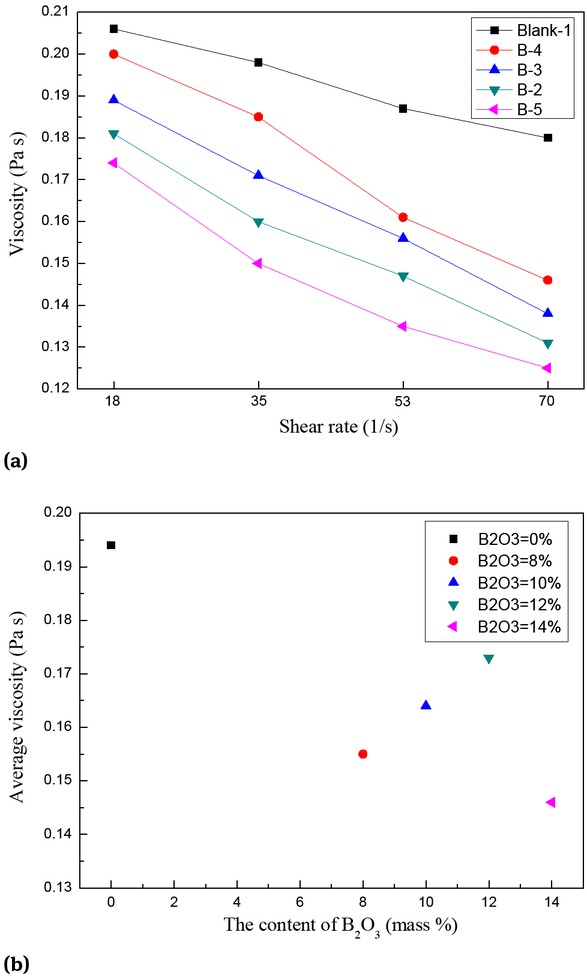
(a) Schematic diagram of viscosity change of mold-flux sample with shear-rate change; (b) schematic diagram of average viscosity of mold flux
The reduction ratio of the viscosity of the mold flux in the same range of shear-rate gradient change was used to measure the strength of the shear-thinning behavior, i.e., the shear-thinning rate. The specific calculation equation is expressed as Eq. (1):
where N represents the shear-thinning rate, ηmax represents the viscosity at a shear rate of 18 s−1, ηmin represents the viscosity at a shear rate of 70 s−1, and Δr′ represents the variation in shear rates.
The calculation results of the shear-thinning rate for each mold-flux sample are presented in Table 2. The minimum shear-thinning rate of the Blank-1 sample was 0.00050, whereas the maximum shear-thinning rate of the B-4 sample was 0.00104. Therefore, we concluded that the B-4 sample exhibited the strongest shear-thinning behavior and that of the Blank-1 sample was weakest. An increase in B2O3 content in the mold flux resulted in an initial increase and then decrease in shear-thinning behavior.
Shear-thinning rate of mold-flux samples
| Sample number | Shear-thinning rate |
|---|---|
| Blank-1 | 0.00050 |
| B-2 | 0.00096 |
| B-3 | 0.00098 |
| B-4 | 0.00104 |
| B-5 | 0.00094 |
Figure 1(b) shows the average viscosity of the mold-flux sample. The average viscosity of the mold flux that contains B2O3 was significantly lower than that of the blank sample. When the content of B2O3 changed from 8% to 12%, the average mold-flux viscosity increased gradually. However, when the content of B2O3 exceeded 12%, the average viscosity of the mold fluxes decreased rapidly. Therefore, it is necessary to conduct an in-depth study on the molecular structure of the mold flux in this process.
3 Molecular-dynamics simulation
After B2O3 addition into the CaO–SiO2–Na2O-based mold flux, the changes in radial distribution function, coordination number and proportion of the Si–O atoms were calculated by molecular-dynamics simulation. The structural-change information and the DP of the mold flux during the process were analyzed, and the influence of B2O3 addition on the shear-thinning property of the mold flux was studied further [11, 12, 13, 14, 15]. The temperature change with time in the simulation process is shown in Figure 2.
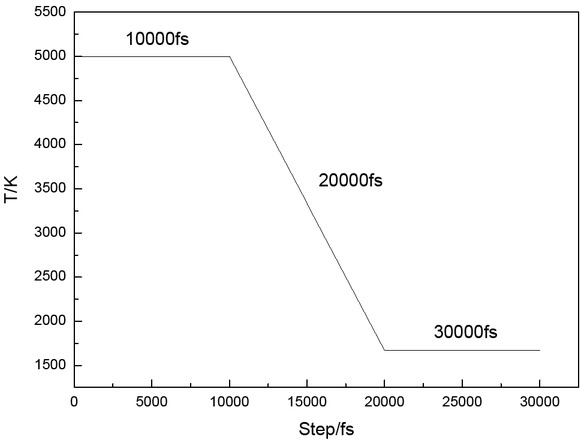
Schematic diagram of temperature variation with time
Table 3 shows the composition of the simulated slag system. Table 4 shows the number of atoms, side length, and density of the box.
Slag compositions
| Slag sample | Alkalinity | Composition (mass %) | |||
|---|---|---|---|---|---|
| CaO | SiO2 | Na2O | B2O3 | ||
| 1 | 1.1 | 48 | 43 | 9 | 0 |
| 2 | 1.1 | 44 | 39 | 9 | 8 |
| 3 | 1.1 | 43 | 38 | 9 | 10 |
| 4 | 1.1 | 41 | 38 | 9 | 12 |
| 5 | 1.1 | 40 | 37 | 9 | 14 |
Simulated particle number and box side length
| Number | Number of particles | The length of the box/Å | Density/g·cm−3 | |||||
|---|---|---|---|---|---|---|---|---|
| Ca | Si | Na | B | O | Total | |||
| 1 | 997 | 834 | 337 | 0 | 2832 | 5000 | 41.232 | 2.758 |
| 2 | 868 | 718 | 320 | 252 | 2842 | 5000 | 40.644 | 2.733 |
| 3 | 838 | 690 | 316 | 312 | 2844 | 5000 | 40.503 | 2.727 |
| 4 | 786 | 680 | 312 | 368 | 2854 | 5000 | 40.380 | 2.709 |
| 5 | 757 | 655 | 308 | 424 | 2856 | 5000 | 40.245 | 2.702 |
Figure 3 shows the simulation results with 12% B2O3. To observe the molecular structure more clearly, one crystal
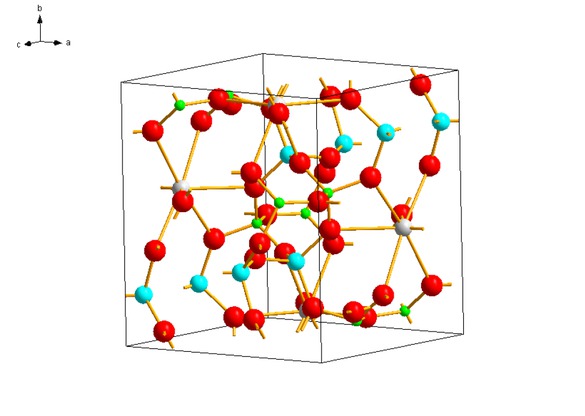
Simulated cell diagram with 12% B2O3 content
cell was selected for observation. The O atoms are red, the Si atoms are blue, the Ca or Na atoms are white, and the B atoms are green. The crystal cell shows that mainly Si and B atoms are involved in bonding. One Si atom connects to four O atoms. Two connection types exist between the B and O atoms; one B atom connects to four O atoms (majority), and one B atom connects to three O atoms (minority). Ca or Na atoms have the least number of bonds, but a high coordination number of O atoms (up to six), which results in their weak control over O atoms.
3.1 Analysis of radial-distribution function and coordination number of CaO–SiO2–Na2O–B2O3-based mold flux
Figure 4 shows the calculated radial-distribution-function and coordinate-distribution diagrams for a 12% B2O3 addition (i.e., the B-4 sample). The abscissa that corresponds to the first peak of the radial distribution function in Figure 4(a)was the bond length that corresponds to the atoms in the mold flux. The bond lengths of B–O, Si–O, Ca–O, and Na–O were 1.35Å, 1.625Å, 2.25Å, and 2.35Å, respectively. The bond lengths of each atomic pair in the quaternary
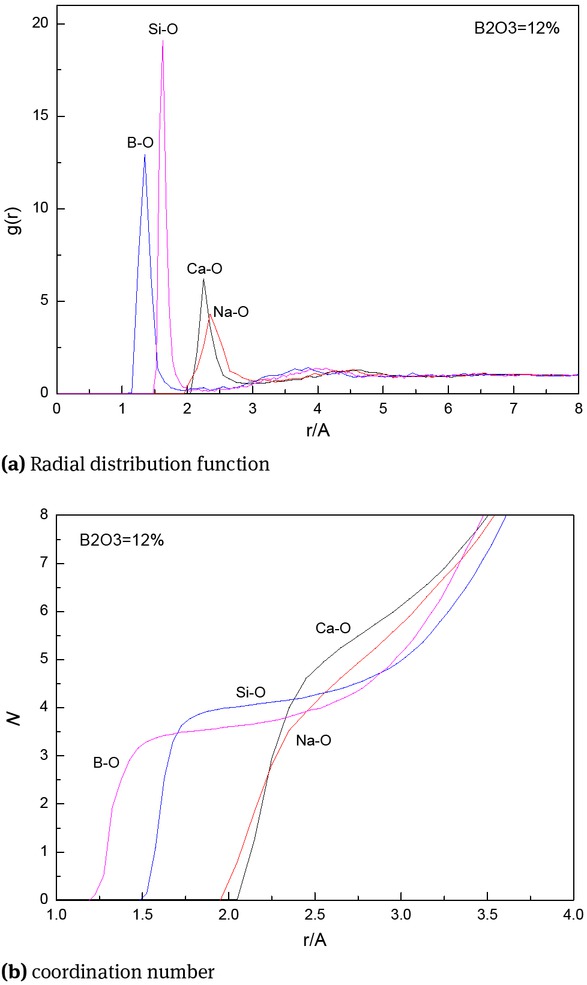
B2O3 content of 12%, radial distribution function and coordination number
slag system show that the binding capacity of the B and O atoms was strongest, followed by Si atoms and then relatively weak Ca and Na atoms, where Na was the weakest.
Figure 4(b) shows that the coordination-number platform of the Si–O bond was stable and long, and its average coordination number was ~4. Therefore, the connection mode of the Si–O bond in the mold flux of the system was mostly the [SiO4] tetrahedral structure. The coordination-number platform of the B–O bond was long and relatively stable, and its average coordination number was ~3.5. The B–O bond also existed as a [BO3] triangle and [BO4] tetrahedron. The Na–O bond had no obvious coordination-number platform, and its bond length was largest. This result indicates that the Na atom had the weakest constraint on O, which was why Na2O as a network exosome oxide would provide more free oxygen atoms. The coordination-number platform of the Ca–O bond was similar to that of the Na–O bond, which indicates that the Ca atom had a similar effect to the Na, but the bond length of the Ca–O bond was smaller, which indicates that it had a strong attraction to the O atom.
3.2 Influence of B2O3 on microstructure and shear-thinning property of CaO–SiO2–Na2O-based mold flux
To study changes in the structure of the [B-O] and other components of the mold flux after B2O3 addition to the CaO–SiO2–Na2O-based mold flux so as to exhibit a shear-thinning property, the coordination information of different B2O3 contents on the Si–O and B–O bonds in the slag system was obtained by simulation calculation, and the coordination structure diagram is shown in Figure 5.
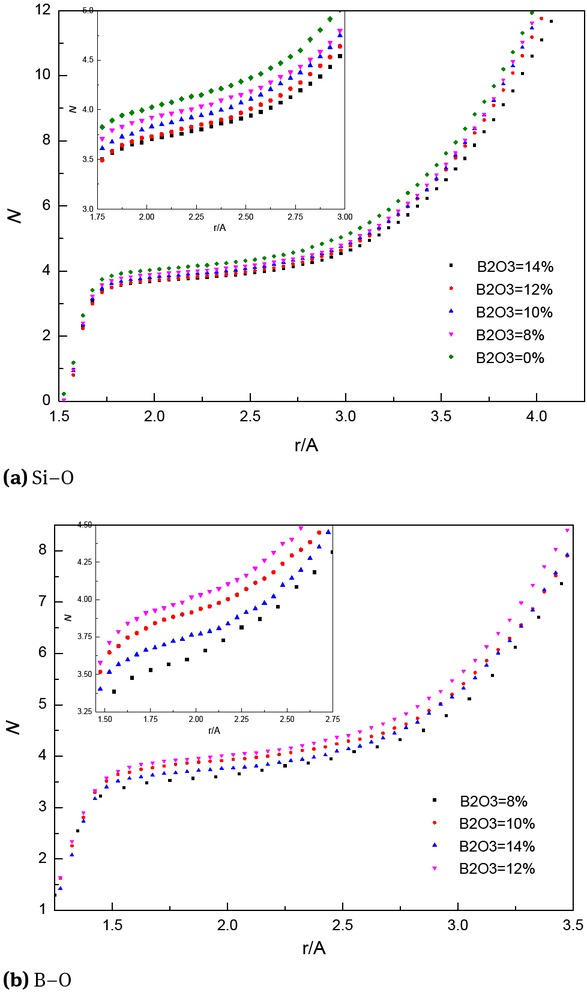
Influence of B2O3 on coordination number
As shown in Figure 5, the coordination structures of Si–O and B–O were relatively stable, but showed some differences. The Si–O coordination number showed that the coordination number of Si–O was maintained at ~4. As shown in Figure 5(a), the average coordination number of the Si–O structure decreased with an increase in B2O3 content in the mold flux. During this process, B atoms that had been added to the mold flux replaced some Si atoms and combined with O atoms to result in a slight decrease in Si–O coordination number. It was also confirmed that the affinity of B and O atoms was stronger than the Si.
As shown in Figure 5(b), when the content of B2O3 changed to 8%–12%, the average coordination number of the B–O bond increased gradually and approached 4. The proportion of [BO4] tetrahedron structure in the mold flux increased gradually, which led to an increase in DP of the mold flux. When the B2O3 content reached 14%, the average coordination number of the B–O bond decreased, which indicates that the proportion of [BO3] triangular structure contained in the slag began to increase and lead to a decrease in DP of the mold flux. The DP of the mold flux was largest when the B2O3 content was 12%.
To study the influence of B2O3 on the degree of aggregation of the Si–O tetrahedron in the mold flux, a search was conducted by programming with the O atom at the center and the Si–O bond length (1.625 Å) as the radius. The search results are shown in Figure 6. N represents the number of Si atoms that are combined with one O atom (i.e., coordination number). The 2-coordinated Si (bridging oxygen) and 1-coordinatied Si (non-bridging oxygen) were connected mainly with O atoms, and the DP of the mold flux could be analyzed from the coordination number of O atoms. An increase in B2O3 content resulted in an increase in number of bridging oxygens and a decrease in the number of non-bridging oxygens. The number of non-bridging oxygens represents the degree of fracture in the system, whereas the number of bridging oxygens represents the DP. When the content of B2O3 in the mold flux was 12%, the number of bridging oxygens in the system was highest and the DP of the mold flux was highest.
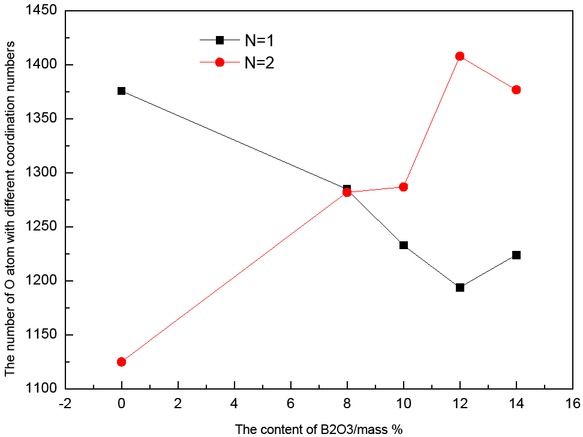
Proportion of O connected to Si atom
According to calculations in previous experiment, when the B2O3 content changed within the range of 8%– 14%, the shear-thinning property of the mold flux increased and then decreased, and when the content of B2O3 was 12% (B-4 sample), the shear-thinning property reached a maximum. This was the same as the change in trend of the DP of the mold flux,which indicates that when the B2O3 content changes in the above range (8%–14%), the strength of the shear-thinning property of the mold flux was in positive proportion to the DP.
4 Quantitative analysis by high-temperature Raman spectroscopy
The B-2, B-3, B-4, and B-5 samples were characterized by high-temperature Raman spectroscopy at 1300∘C. Figure 7(a) presents the Raman spectrum of the B-4 sample, in which the B2O3 content was 12%. Figure 7(b) shows the peak deconvolution spectrum of the B-4 sample, as obtained by using the PEAKFIT software, in the Raman shift range from 1200 to 800 cm−1.
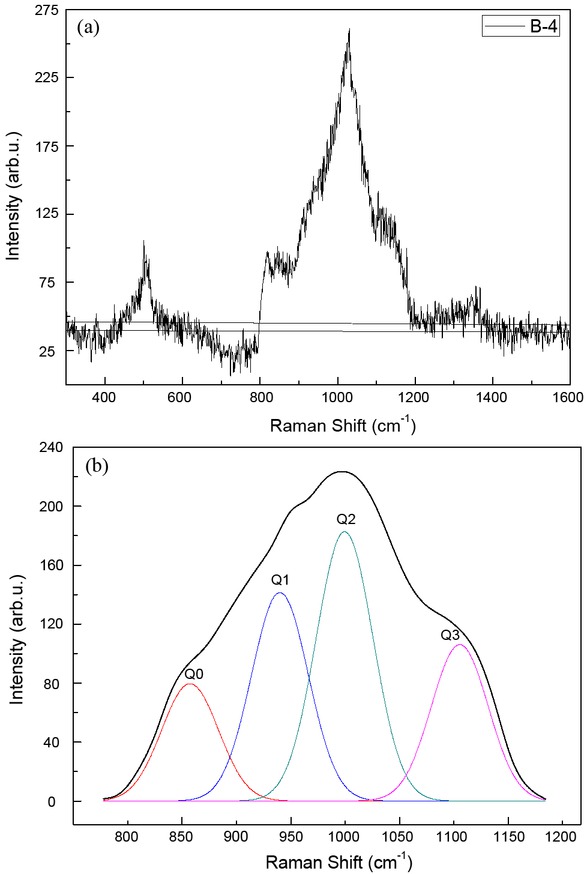
(a) B-4 sample Raman spectrum at 1300∘C, (b) B-4 sample peak resolution spectra at 1300∘C
Figure 7(a) shows two relatively obvious peak values in the range of Raman displacement of 600–400 cm−1 and 1200–800 cm−1, respectively. Among them, the spectral peak with a Raman displacement of 600–400 cm−1 contained some simple Si–Ob–Si or Si–Onb connection structures [16, 17]. However, the spectral peak of Raman displacement for 1200–800 cm−1 contained some Qn structural units and [BO4] tetrahedral structural units [16, 17]. A small peak occurred where the Raman displacement was 1450–1300 cm−1, which contained a two-dimensional [BO3] triangular structure [16, 17].
Figure 7(b) shows abundantly dispersed anion structural-unit (Qn) information around the Raman shift at 1200–800 cm−1. The peaks at 860, 936, 1000, and 1110 cm−1 correspond to the Q0

Molecular diagrams of all five scattered anion structural units
The DP and molecular concentration within the mold flux were calculated from the Raman spectroscopic data. The polymerization reaction in the mold flux is represented by Eqs. (2) to (4):
where K is the equilibrium constant, C2 and C3 represent the concentration of Q2 and Q3, respectively, and C4 represents the concentration of the molecular polymerization units. According to Eq. (4), the C4 could be calculated from C3/C2; therefore, in this work, C3/C2 was considered to represent the DP of the equilibrium system that was established through the reactions among the silicate structural units within the mold flux [19, 20].
To analyze the changes in Qn structural units and the variation law of DP in the CaO–SiO2–Na2O–B2O3 mold flux, the relative areas of each anion structural unit in the B-2, B-3, B-4, and B-5 samples were best-fitted to a Gaussian function. The results are presented in Table 5.
Peak relative-area ratios and DP obtained from Raman data through Gaussian fitting
| Sample number | Basicity (CaO/SiO2) | DP (C3/C2) | Best-fitted Gaussian peak area ratio | |||
|---|---|---|---|---|---|---|
| C0 | C1 | C2 | C3 | |||
| B-2 | 1.1 | 0.86 | 0.148 | 0.272 | 0.312 | 0.268 |
| B-3 | 1.1 | 0.88 | 0.126 | 0.290 | 0.311 | 0.273 |
| B-4 | 1.1 | 0.96 | 0.145 | 0.285 | 0.291 | 0.279 |
| B-5 | 1.1 | 0.84 | 0.162 | 0.269 | 0.309 | 0.260 |
As shown in Table 5, when the content of B2O3 in the slag changed from 8% to 12% (samples B-2 to B-4), the relative proportional area (C2) of the structural unit of Q2 decreased gradually, and the relative proportional area (C3) of the structural unit of Q3 increased gradually. At this point, C3/C2 increased gradually, that is, the DP of the mold flux increased gradually. However, when the content of B2O3 in the slag changed from 12% to 14% (samples B-4 to B-5), C2 increased and C3 decreased. At this point, C3/C2 decreased, that is, the DP of the mold flux decreased. Therefore, when the content of B2O3 in the slag changed from 8% to 14% (samples B-2 to B-5), the DP of the mold flux increased initially and then decreased, and reached a maximum for the B-4 sample. The experimental results were consistent with the molecular-dynamics simulation results.
The simulation and experimental results indicated that when the B2O3 content varied from 0% to 12%, most of the B2O3 existed in the mold flux as a three-dimensional [BO4] tetrahedral structure, whereas a few existed as two-dimensional [BO3] triangular structures. This occurs mainly because the alkali-metal oxide Na2O in the slag has a relatively weak control of the O atoms, and it is easy to provide free O atoms. The bonding ability between the B and O atoms is strongest, so the free O atom in the slag will bond preferentially with the B atom to form a three-dimensional [BO4] tetrahedron structure, which will increase the DP in the mold flux. The reaction principle is shown in Figure 9.

Schematic diagram of polymerization
When the content of B2O3 changes from 12% to 14%, the content of B2O3 exceeds the content of Na2O (11%), the CaO with the highest content in the mold flux begins to play a role as a network-modifying oxide. This decomposes most three-dimensional [BO4] tetrahedral structures into two-dimensional [BO3] triangular structures, and results in a decreased DP of the mold flux. The reaction principle is shown in Figure 10. Therefore, the DP of sample B-4 (B2O3 content of 12%) is highest in the CaO–SiO2–Na2O– B2O3 non-Newtonian fluid mold flux.

Schematic diagram of depolymerization
In conclusion, the shear-thinning property of the mold flux is related directly to the DP, and the DP is related to the amount of B2O3. When the content of B2O3 varies from 0% to 12%, the DP of the mold flux increases, and the shear-thinning property increases. When the content of B2O3 varies from 12% to 14%, the DP of the mold flux decreases, and the shear-thinning property decreases. The results show that when the B2O3 content was 12%, the shear-thinning property of the mold flux was strongest.
5 Applications to continuous casting
During continuous casting, the mold flux is critical as a lubricating agent at the mold wall where the shear rate is assumed to range between 100 and 1000 s−1. In this case, the low viscosity of the mold flux is desirable to maximize the lubrication capacity [9]. Figure 11 shows the conceptual effect of the CaO–SiO2–Na2O–B2O3 non-Newtonian fluid mold flux (B-4 sample) during continuous casting.
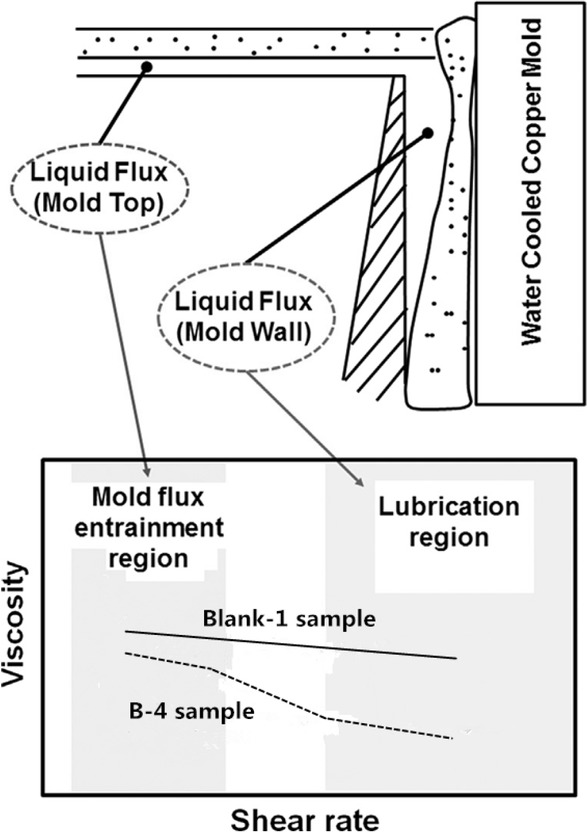
Schematic diagram showing conceptual effect of CaO– SiO2–Na2O–B2O3 non-Newtonian fluid mold flux during continuous steel casting
To verify the practical application of a non-Newtonian fluid mold flux with shear-thinning properties, samples Blank-1 and B-4 (after compounding with a certain amount of carbon) were used separately in square-billet casting tests at the multifunctional continuous-casting experimental stage. The section size of the casting mold was 100 mm× 100 mm, the pulling rate was 1.9 m/min, and the slag consumption was 0.2 kg/t. The as-cast steel composition is presented in Table 6.
Composition of as-cast low-carbon steel mass%
| C | Si | Mn | P | S |
|---|---|---|---|---|
| 0.01–0.08 | ≤ 0.008 | ≤ 0.15 | ≤ 0.02 | ≤ 0.02 |
Figure 12 shows the casting-slab surface morphology when samples Blank-1 and B-4 were used. The surface of the Blank-1 as-cast slab was rough, with a relatively serious slag-sticking phenomenon, which causes problems in subsequent rolling and molding steps. The surface of
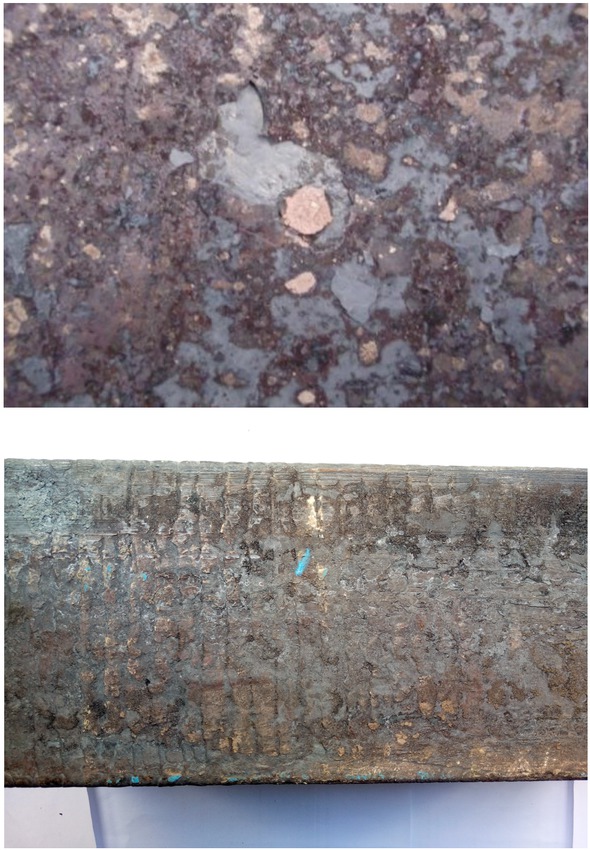
Surface morphologies of casting slabs: (a) Blank-1 sample, (b) B-4 sample
the B-4 as-cast slab was relatively smooth, where the slag sticking phenomenon improved visibly. The casting quality, however, was improved substantially. This improvement in casting quality is attributed primarily to the B-4 sample showing a strong shear-thinning, which resulted in a relatively low viscosity in the lubricating area at a high shear rate, and lead to a significant improvement in its lubricating ability (Figure 11), so that the casting quality was improved visibly.
6 Conclusions
The shear-thinning property of the CaO–SiO2– Na2O–B2O3 non-Newtonian fluid mold flux differed from that of the CaO–SiO2–Na2O-based mold flux. When the B2O3 content varied from 0% to 12%, the DP increased because of the increasing proportion of [BO4] tetrahedron structures in the mold flux. When the B2O3 content changed at 12%–14%, its content exceeded the Na2O content in the slag. CaO in the mold flux as a network-modifying oxide promotes the depolymerization reaction so that the proportion of [BO3] triangular structure increases and results in a decrease in DP. When the content of B2O3 was 12%, the DP of the mold flux was highest and the shear-thinning property was strongest.
Blank-1 and the B-4 mold-flux samples were used in laboratory square-billet casting tests. The slag-sticking phenomenon on the surface of the billet with sample Blank-1 was relatively serious; however, the phenomenon decreased and the surface quality of the billet improved significantly when the B-4 sample was used. This new type of mold flux has good application prospects in the field of low carbon-steel casting.
Acknowledgement
We would like to acknowledge the financial support provided by the National Natural Science Foundation of China (Nos. 51774141 and 51604119).
References
[1] S.H. Shin, D.W. Yoon, J.W. Cho, and S.H. Kim, J. Non-Cryst. Solids, 425 (2015) 83-90.10.1016/j.jnoncrysol.2015.05.032Search in Google Scholar
[2] S.H. Shin, J.W. Cho, and S.H. Kim, J. Non-Cryst. Solids, 423 (2015) 45-49.10.1016/j.jnoncrysol.2015.04.043Search in Google Scholar
[3] S.H. Shin, J.W. Cho, and S.H. Kim, J. Am. Ceram. Soc., 97 (2014) 3263-3269.10.1111/jace.13149Search in Google Scholar
[4] X.Z. Ma, Steelmak., 1 (1996) 7-10.Search in Google Scholar
[5] T.M. Ye, W.J. Xiao, J.P He, J.P. Wang, and Z.F. Zhao, Steelmak., 25(2009)12-15.Search in Google Scholar
[6] Y. Gu, R.Z. Liu, K. Wu, Y. Zhao, S.Q. Li, X. Gao, and G.J. Sun, Spec. Steel., 25 (2004) 18-21.Search in Google Scholar
[7] H.X. Mao, C.G. Bai, G.B. Qiu, D.F. Chen, L.Y. Wen, and L.Y. Dong, J. Cho. Uni., 28 (2005) 52-55.Search in Google Scholar
[8] K. Watanabe, K. Tsutsumi, M. Suzuki, H. Fujita, S. Hatori, T. Suzuki, and T. Omoto, ISIJ Int., 54 (2014) 865-871.10.2355/isijinternational.54.865Search in Google Scholar
[9] H.S. Seung, W.C. Jung and H.K. Seon, Mater. Des., 76 (2015) 1-8.10.1016/j.matdes.2015.03.035Search in Google Scholar
[10] D.M. Li, M.T. Shao, X.L. Yang, and C.M. Diao, Application Technology of Mold Flux for Continuous Casting, Metallurgical Industry Press, Beijing (2008).Search in Google Scholar
[11] S. Won and F. Tsukihashi, ISIJ Int., 44 (2007) 1817-1825.Search in Google Scholar
[12] Y.Q. Wu, Study on the microstructure of silicate melt and its relationship with macroscopic properties, Shanghai University (2004).Search in Google Scholar
[13] Y.H. Wen, R.Z. Zhu, F.X. Zhou, and C.Y.Wang, Adv. Mec., 33 (2003) 65-73.Search in Google Scholar
[14] Q. Wang and Y. Sun, Shanxi. Coal., 3 (2009) 46-47.Search in Google Scholar
[15] M.R. An, Effects of twin and stack-layer faults on mechanical properties of nanocrystalline metal materials, Xi’an University of Posts and Telecommunications (2013).Search in Google Scholar
[16] A. Bachar, C. Mercier, A. Tricoteaux, A. Leriche, and C. Follet, Non-Cryst. Solids., 358 (2012) 693-701.10.1016/j.jnoncrysol.2011.11.036Search in Google Scholar
[17] M. Bradley, Curve fitting in Raman and IR spectroscopy: basic theory of line shapes and applications, Thermo Fischer Scientific, Madison (2007), pp. 376-379.Search in Google Scholar
[18] E. Dolekcekic, M.J. Pomerpocy, and S. Hampshire, J. Eur. Ceram. Soc., 27 (2007) 893-897.10.1016/j.jeurceramsoc.2006.04.058Search in Google Scholar
[19] J.H. Park, Metall. Mater. Trans. B, 44 (2013) 938-942.10.1007/s11663-013-9825-9Search in Google Scholar
[20] J.H. Park, Met. Mater. Int., 19 (2013) 577-581.10.1007/s12540-013-3028-4Search in Google Scholar
© 2019 L. Zhu et al., published by De Gruyter
This work is licensed under the Creative Commons Attribution 4.0 Public License.
Articles in the same Issue
- Frontmatter
- Review Article
- Research on the Influence of Furnace Structure on Copper Cooling Stave Life
- Influence of High Temperature Oxidation on Hydrogen Absorption and Degradation of Zircaloy-2 and Zr 700 Alloys
- Correlation between Travel Speed, Microstructure, Mechanical Properties and Wear Characteristics of Ni-Based Hardfaced Deposits over 316LN Austenitic Stainless Steel
- Factors Influencing Gas Generation Behaviours of Lump Coal Used in COREX Gasifier
- Experiment Research on Pulverized Coal Combustion in the Tuyere of Oxygen Blast Furnace
- Phosphate Capacities of CaO–FeO–SiO2–Al2O3/Na2O/TiO2 Slags
- Microstructure and Interface Bonding Strength of WC-10Ni/NiCrBSi Composite Coating by Vacuum Brazing
- Refill Friction Stir Spot Welding of Dissimilar 6061/7075 Aluminum Alloy
- Solvothermal Synthesis and Magnetic Properties of Monodisperse Ni0.5Zn0.5Fe2O4 Hollow Nanospheres
- On the Capability of Logarithmic-Power Model for Prediction of Hot Deformation Behavior of Alloy 800H at High Strain Rates
- 3D Heat Conductivity Model of Mold Based on Node Temperature Inheritance
- 3D Microstructure and Micromechanical Properties of Minerals in Vanadium-Titanium Sinter
- Effect of Martensite Structure and Carbide Precipitates on Mechanical Properties of Cr-Mo Alloy Steel with Different Cooling Rate
- The Interaction between Erosion Particle and Gas Stream in High Temperature Gas Burner Rig for Thermal Barrier Coatings
- Permittivity Study of a CuCl Residue at 13–450 °C and Elucidation of the Microwave Intensification Mechanism for Its Dechlorination
- Study on Carbothermal Reduction of Titania in Molten Iron
- The Sequence of the Phase Growth during Diffusion in Ti-Based Systems
- Growth Kinetics of CoB–Co2B Layers Using the Powder-Pack Boriding Process Assisted by a Direct Current Field
- High-Temperature Flow Behaviour and Constitutive Equations for a TC17 Titanium Alloy
- Research on Three-Roll Screw Rolling Process for Ti6Al4V Titanium Alloy Bar
- Continuous Cooling Transformation of Undeformed and Deformed High Strength Crack-Arrest Steel Plates for Large Container Ships
- Formation Mechanism and Influence Factors of the Sticker between Solidified Shell and Mold in Continuous Casting of Steel
- Casting Defects in Transition Layer of Cu/Al Composite Castings Prepared Using Pouring Aluminum Method and Their Formation Mechanism
- Effect of Current on Segregation and Inclusions Characteristics of Dual Alloy Ingot Processed by Electroslag Remelting
- Investigation of Growth Kinetics of Fe2B Layers on AISI 1518 Steel by the Integral Method
- Microstructural Evolution and Phase Transformation on the X-Y Surface of Inconel 718 Ni-Based Alloys Fabricated by Selective Laser Melting under Different Heat Treatment
- Characterization of Mn-Doped Co3O4 Thin Films Prepared by Sol Gel-Based Dip-Coating Process
- Deposition Characteristics of Multitrack Overlayby Plasma Transferred Arc Welding on SS316Lwith Co-Cr Based Alloy – Influence ofProcess Parameters
- Elastic Moduli and Elastic Constants of Alloy AuCuSi With FCC Structure Under Pressure
- Effect of Cl on Softening and Melting Behaviors of BF Burden
- Effect of MgO Injection on Smelting in a Blast Furnace
- Structural Characteristics and Hydration Kinetics of Oxidized Steel Slag in a CaO-FeO-SiO2-MgO System
- Optimization of Microwave-Assisted Oxidation Roasting of Oxide–Sulphide Zinc Ore with Addition of Manganese Dioxide Using Response Surface Methodology
- Hydraulic Study of Bubble Migration in Liquid Titanium Alloy Melt during Vertical Centrifugal Casting Process
- Investigation on Double Wire Metal Inert Gas Welding of A7N01-T4 Aluminum Alloy in High-Speed Welding
- Oxidation Behaviour of Welded ASTM-SA210 GrA1 Boiler Tube Steels under Cyclic Conditions at 900°C in Air
- Study on the Evolution of Damage Degradation at Different Temperatures and Strain Rates for Ti-6Al-4V Alloy
- Pack-Boriding of Pure Iron with Powder Mixtures Containing ZrB2
- Evolution of Interfacial Features of MnO-SiO2 Type Inclusions/Steel Matrix during Isothermal Heating at Low Temperatures
- Effect of MgO/Al2O3 Ratio on Viscosity of Blast Furnace Primary Slag
- The Microstructure and Property of the Heat Affected zone in C-Mn Steel Treated by Rare Earth
- Microwave-Assisted Molten-Salt Facile Synthesis of Chromium Carbide (Cr3C2) Coatings on the Diamond Particles
- Effects of B on the Hot Ductility of Fe-36Ni Invar Alloy
- Impurity Distribution after Solidification of Hypereutectic Al-Si Melts and Eutectic Al-Si Melt
- Induced Electro-Deposition of High Melting-Point Phases on MgO–C Refractory in CaO–Al2O3–SiO2 – (MgO) Slag at 1773 K
- Microstructure and Mechanical Properties of 14Cr-ODS Steels with Zr Addition
- A Review of Boron-Rich Silicon Borides Basedon Thermodynamic Stability and Transport Properties of High-Temperature Thermoelectric Materials
- Siliceous Manganese Ore from Eastern India:A Potential Resource for Ferrosilicon-Manganese Production
- A Strain-Compensated Constitutive Model for Describing the Hot Compressive Deformation Behaviors of an Aged Inconel 718 Superalloy
- Surface Alloys of 0.45 C Carbon Steel Produced by High Current Pulsed Electron Beam
- Deformation Behavior and Processing Map during Isothermal Hot Compression of 49MnVS3 Non-Quenched and Tempered Steel
- A Constitutive Equation for Predicting Elevated Temperature Flow Behavior of BFe10-1-2 Cupronickel Alloy through Double Multiple Nonlinear Regression
- Oxidation Behavior of Ferritic Steel T22 Exposed to Supercritical Water
- A Multi Scale Strategy for Simulation of Microstructural Evolutions in Friction Stir Welding of Duplex Titanium Alloy
- Partition Behavior of Alloying Elements in Nickel-Based Alloys and Their Activity Interaction Parameters and Infinite Dilution Activity Coefficients
- Influence of Heating on Tensile Physical-Mechanical Properties of Granite
- Comparison of Al-Zn-Mg Alloy P-MIG Welded Joints Filled with Different Wires
- Microstructure and Mechanical Properties of Thick Plate Friction Stir Welds for 6082-T6 Aluminum Alloy
- Research Article
- Kinetics of oxide scale growth on a (Ti, Mo)5Si3 based oxidation resistant Mo-Ti-Si alloy at 900-1300∘C
- Calorimetric study on Bi-Cu-Sn alloys
- Mineralogical Phase of Slag and Its Effect on Dephosphorization during Converter Steelmaking Using Slag-Remaining Technology
- Controllability of joint integrity and mechanical properties of friction stir welded 6061-T6 aluminum and AZ31B magnesium alloys based on stationary shoulder
- Cellular Automaton Modeling of Phase Transformation of U-Nb Alloys during Solidification and Consequent Cooling Process
- The effect of MgTiO3Adding on Inclusion Characteristics
- Cutting performance of a functionally graded cemented carbide tool prepared by microwave heating and nitriding sintering
- Creep behaviour and life assessment of a cast nickel – base superalloy MAR – M247
- Failure mechanism and acoustic emission signal characteristics of coatings under the condition of impact indentation
- Reducing Surface Cracks and Improving Cleanliness of H-Beam Blanks in Continuous Casting — Improving continuous casting of H-beam blanks
- Rhodium influence on the microstructure and oxidation behaviour of aluminide coatings deposited on pure nickel and nickel based superalloy
- The effect of Nb content on precipitates, microstructure and texture of grain oriented silicon steel
- Effect of Arc Power on the Wear and High-temperature Oxidation Resistances of Plasma-Sprayed Fe-based Amorphous Coatings
- Short Communication
- Novel Combined Feeding Approach to Produce Quality Al6061 Composites for Heat Sinks
- Research Article
- Micromorphology change and microstructure of Cu-P based amorphous filler during heating process
- Controlling residual stress and distortion of friction stir welding joint by external stationary shoulder
- Research on the ingot shrinkage in the electroslag remelting withdrawal process for 9Cr3Mo roller
- Production of Mo2NiB2 Based Hard Alloys by Self-Propagating High-Temperature Synthesis
- The Morphology Analysis of Plasma-Sprayed Cast Iron Splats at Different Substrate Temperatures via Fractal Dimension and Circularity Methods
- A Comparative Study on Johnson–Cook, Modified Johnson–Cook, Modified Zerilli–Armstrong and Arrhenius-Type Constitutive Models to Predict Hot Deformation Behavior of TA2
- Dynamic absorption efficiency of paracetamol powder in microwave drying
- Preparation and Properties of Blast Furnace Slag Glass Ceramics Containing Cr2O3
- Influence of unburned pulverized coal on gasification reaction of coke in blast furnace
- Effect of PWHT Conditions on Toughness and Creep Rupture Strength in Modified 9Cr-1Mo Steel Welds
- Role of B2O3 on structure and shear-thinning property in CaO–SiO2–Na2O-based mold fluxes
- Effect of Acid Slag Treatment on the Inclusions in GCr15 Bearing Steel
- Recovery of Iron and Zinc from Blast Furnace Dust Using Iron-Bath Reduction
- Phase Analysis and Microstructural Investigations of Ce2Zr2O7 for High-Temperature Coatings on Ni-Base Superalloy Substrates
- Combustion Characteristics and Kinetics Study of Pulverized Coal and Semi-Coke
- Mechanical and Electrochemical Characterization of Supersolidus Sintered Austenitic Stainless Steel (316 L)
- Synthesis and characterization of Cu doped chromium oxide (Cr2O3) thin films
- Ladle Nozzle Clogging during casting of Silicon-Steel
- Thermodynamics and Industrial Trial on Increasing the Carbon Content at the BOF Endpoint to Produce Ultra-Low Carbon IF Steel by BOF-RH-CSP Process
- Research Article
- Effect of Boundary Conditions on Residual Stresses and Distortion in 316 Stainless Steel Butt Welded Plate
- Numerical Analysis on Effect of Additional Gas Injection on Characteristics around Raceway in Melter Gasifier
- Variation on thermal damage rate of granite specimen with thermal cycle treatment
- Effects of Fluoride and Sulphate Mineralizers on the Properties of Reconstructed Steel Slag
- Effect of Basicity on Precipitation of Spinel Crystals in a CaO-SiO2-MgO-Cr2O3-FeO System
- Review Article
- Exploitation of Mold Flux for the Ti-bearing Welding Wire Steel ER80-G
- Research Article
- Furnace heat prediction and control model and its application to large blast furnace
- Effects of Different Solid Solution Temperatures on Microstructure and Mechanical Properties of the AA7075 Alloy After T6 Heat Treatment
- Study of the Viscosity of a La2O3-SiO2-FeO Slag System
- Tensile Deformation and Work Hardening Behaviour of AISI 431 Martensitic Stainless Steel at Elevated Temperatures
- The Effectiveness of Reinforcement and Processing on Mechanical Properties, Wear Behavior and Damping Response of Aluminum Matrix Composites
Articles in the same Issue
- Frontmatter
- Review Article
- Research on the Influence of Furnace Structure on Copper Cooling Stave Life
- Influence of High Temperature Oxidation on Hydrogen Absorption and Degradation of Zircaloy-2 and Zr 700 Alloys
- Correlation between Travel Speed, Microstructure, Mechanical Properties and Wear Characteristics of Ni-Based Hardfaced Deposits over 316LN Austenitic Stainless Steel
- Factors Influencing Gas Generation Behaviours of Lump Coal Used in COREX Gasifier
- Experiment Research on Pulverized Coal Combustion in the Tuyere of Oxygen Blast Furnace
- Phosphate Capacities of CaO–FeO–SiO2–Al2O3/Na2O/TiO2 Slags
- Microstructure and Interface Bonding Strength of WC-10Ni/NiCrBSi Composite Coating by Vacuum Brazing
- Refill Friction Stir Spot Welding of Dissimilar 6061/7075 Aluminum Alloy
- Solvothermal Synthesis and Magnetic Properties of Monodisperse Ni0.5Zn0.5Fe2O4 Hollow Nanospheres
- On the Capability of Logarithmic-Power Model for Prediction of Hot Deformation Behavior of Alloy 800H at High Strain Rates
- 3D Heat Conductivity Model of Mold Based on Node Temperature Inheritance
- 3D Microstructure and Micromechanical Properties of Minerals in Vanadium-Titanium Sinter
- Effect of Martensite Structure and Carbide Precipitates on Mechanical Properties of Cr-Mo Alloy Steel with Different Cooling Rate
- The Interaction between Erosion Particle and Gas Stream in High Temperature Gas Burner Rig for Thermal Barrier Coatings
- Permittivity Study of a CuCl Residue at 13–450 °C and Elucidation of the Microwave Intensification Mechanism for Its Dechlorination
- Study on Carbothermal Reduction of Titania in Molten Iron
- The Sequence of the Phase Growth during Diffusion in Ti-Based Systems
- Growth Kinetics of CoB–Co2B Layers Using the Powder-Pack Boriding Process Assisted by a Direct Current Field
- High-Temperature Flow Behaviour and Constitutive Equations for a TC17 Titanium Alloy
- Research on Three-Roll Screw Rolling Process for Ti6Al4V Titanium Alloy Bar
- Continuous Cooling Transformation of Undeformed and Deformed High Strength Crack-Arrest Steel Plates for Large Container Ships
- Formation Mechanism and Influence Factors of the Sticker between Solidified Shell and Mold in Continuous Casting of Steel
- Casting Defects in Transition Layer of Cu/Al Composite Castings Prepared Using Pouring Aluminum Method and Their Formation Mechanism
- Effect of Current on Segregation and Inclusions Characteristics of Dual Alloy Ingot Processed by Electroslag Remelting
- Investigation of Growth Kinetics of Fe2B Layers on AISI 1518 Steel by the Integral Method
- Microstructural Evolution and Phase Transformation on the X-Y Surface of Inconel 718 Ni-Based Alloys Fabricated by Selective Laser Melting under Different Heat Treatment
- Characterization of Mn-Doped Co3O4 Thin Films Prepared by Sol Gel-Based Dip-Coating Process
- Deposition Characteristics of Multitrack Overlayby Plasma Transferred Arc Welding on SS316Lwith Co-Cr Based Alloy – Influence ofProcess Parameters
- Elastic Moduli and Elastic Constants of Alloy AuCuSi With FCC Structure Under Pressure
- Effect of Cl on Softening and Melting Behaviors of BF Burden
- Effect of MgO Injection on Smelting in a Blast Furnace
- Structural Characteristics and Hydration Kinetics of Oxidized Steel Slag in a CaO-FeO-SiO2-MgO System
- Optimization of Microwave-Assisted Oxidation Roasting of Oxide–Sulphide Zinc Ore with Addition of Manganese Dioxide Using Response Surface Methodology
- Hydraulic Study of Bubble Migration in Liquid Titanium Alloy Melt during Vertical Centrifugal Casting Process
- Investigation on Double Wire Metal Inert Gas Welding of A7N01-T4 Aluminum Alloy in High-Speed Welding
- Oxidation Behaviour of Welded ASTM-SA210 GrA1 Boiler Tube Steels under Cyclic Conditions at 900°C in Air
- Study on the Evolution of Damage Degradation at Different Temperatures and Strain Rates for Ti-6Al-4V Alloy
- Pack-Boriding of Pure Iron with Powder Mixtures Containing ZrB2
- Evolution of Interfacial Features of MnO-SiO2 Type Inclusions/Steel Matrix during Isothermal Heating at Low Temperatures
- Effect of MgO/Al2O3 Ratio on Viscosity of Blast Furnace Primary Slag
- The Microstructure and Property of the Heat Affected zone in C-Mn Steel Treated by Rare Earth
- Microwave-Assisted Molten-Salt Facile Synthesis of Chromium Carbide (Cr3C2) Coatings on the Diamond Particles
- Effects of B on the Hot Ductility of Fe-36Ni Invar Alloy
- Impurity Distribution after Solidification of Hypereutectic Al-Si Melts and Eutectic Al-Si Melt
- Induced Electro-Deposition of High Melting-Point Phases on MgO–C Refractory in CaO–Al2O3–SiO2 – (MgO) Slag at 1773 K
- Microstructure and Mechanical Properties of 14Cr-ODS Steels with Zr Addition
- A Review of Boron-Rich Silicon Borides Basedon Thermodynamic Stability and Transport Properties of High-Temperature Thermoelectric Materials
- Siliceous Manganese Ore from Eastern India:A Potential Resource for Ferrosilicon-Manganese Production
- A Strain-Compensated Constitutive Model for Describing the Hot Compressive Deformation Behaviors of an Aged Inconel 718 Superalloy
- Surface Alloys of 0.45 C Carbon Steel Produced by High Current Pulsed Electron Beam
- Deformation Behavior and Processing Map during Isothermal Hot Compression of 49MnVS3 Non-Quenched and Tempered Steel
- A Constitutive Equation for Predicting Elevated Temperature Flow Behavior of BFe10-1-2 Cupronickel Alloy through Double Multiple Nonlinear Regression
- Oxidation Behavior of Ferritic Steel T22 Exposed to Supercritical Water
- A Multi Scale Strategy for Simulation of Microstructural Evolutions in Friction Stir Welding of Duplex Titanium Alloy
- Partition Behavior of Alloying Elements in Nickel-Based Alloys and Their Activity Interaction Parameters and Infinite Dilution Activity Coefficients
- Influence of Heating on Tensile Physical-Mechanical Properties of Granite
- Comparison of Al-Zn-Mg Alloy P-MIG Welded Joints Filled with Different Wires
- Microstructure and Mechanical Properties of Thick Plate Friction Stir Welds for 6082-T6 Aluminum Alloy
- Research Article
- Kinetics of oxide scale growth on a (Ti, Mo)5Si3 based oxidation resistant Mo-Ti-Si alloy at 900-1300∘C
- Calorimetric study on Bi-Cu-Sn alloys
- Mineralogical Phase of Slag and Its Effect on Dephosphorization during Converter Steelmaking Using Slag-Remaining Technology
- Controllability of joint integrity and mechanical properties of friction stir welded 6061-T6 aluminum and AZ31B magnesium alloys based on stationary shoulder
- Cellular Automaton Modeling of Phase Transformation of U-Nb Alloys during Solidification and Consequent Cooling Process
- The effect of MgTiO3Adding on Inclusion Characteristics
- Cutting performance of a functionally graded cemented carbide tool prepared by microwave heating and nitriding sintering
- Creep behaviour and life assessment of a cast nickel – base superalloy MAR – M247
- Failure mechanism and acoustic emission signal characteristics of coatings under the condition of impact indentation
- Reducing Surface Cracks and Improving Cleanliness of H-Beam Blanks in Continuous Casting — Improving continuous casting of H-beam blanks
- Rhodium influence on the microstructure and oxidation behaviour of aluminide coatings deposited on pure nickel and nickel based superalloy
- The effect of Nb content on precipitates, microstructure and texture of grain oriented silicon steel
- Effect of Arc Power on the Wear and High-temperature Oxidation Resistances of Plasma-Sprayed Fe-based Amorphous Coatings
- Short Communication
- Novel Combined Feeding Approach to Produce Quality Al6061 Composites for Heat Sinks
- Research Article
- Micromorphology change and microstructure of Cu-P based amorphous filler during heating process
- Controlling residual stress and distortion of friction stir welding joint by external stationary shoulder
- Research on the ingot shrinkage in the electroslag remelting withdrawal process for 9Cr3Mo roller
- Production of Mo2NiB2 Based Hard Alloys by Self-Propagating High-Temperature Synthesis
- The Morphology Analysis of Plasma-Sprayed Cast Iron Splats at Different Substrate Temperatures via Fractal Dimension and Circularity Methods
- A Comparative Study on Johnson–Cook, Modified Johnson–Cook, Modified Zerilli–Armstrong and Arrhenius-Type Constitutive Models to Predict Hot Deformation Behavior of TA2
- Dynamic absorption efficiency of paracetamol powder in microwave drying
- Preparation and Properties of Blast Furnace Slag Glass Ceramics Containing Cr2O3
- Influence of unburned pulverized coal on gasification reaction of coke in blast furnace
- Effect of PWHT Conditions on Toughness and Creep Rupture Strength in Modified 9Cr-1Mo Steel Welds
- Role of B2O3 on structure and shear-thinning property in CaO–SiO2–Na2O-based mold fluxes
- Effect of Acid Slag Treatment on the Inclusions in GCr15 Bearing Steel
- Recovery of Iron and Zinc from Blast Furnace Dust Using Iron-Bath Reduction
- Phase Analysis and Microstructural Investigations of Ce2Zr2O7 for High-Temperature Coatings on Ni-Base Superalloy Substrates
- Combustion Characteristics and Kinetics Study of Pulverized Coal and Semi-Coke
- Mechanical and Electrochemical Characterization of Supersolidus Sintered Austenitic Stainless Steel (316 L)
- Synthesis and characterization of Cu doped chromium oxide (Cr2O3) thin films
- Ladle Nozzle Clogging during casting of Silicon-Steel
- Thermodynamics and Industrial Trial on Increasing the Carbon Content at the BOF Endpoint to Produce Ultra-Low Carbon IF Steel by BOF-RH-CSP Process
- Research Article
- Effect of Boundary Conditions on Residual Stresses and Distortion in 316 Stainless Steel Butt Welded Plate
- Numerical Analysis on Effect of Additional Gas Injection on Characteristics around Raceway in Melter Gasifier
- Variation on thermal damage rate of granite specimen with thermal cycle treatment
- Effects of Fluoride and Sulphate Mineralizers on the Properties of Reconstructed Steel Slag
- Effect of Basicity on Precipitation of Spinel Crystals in a CaO-SiO2-MgO-Cr2O3-FeO System
- Review Article
- Exploitation of Mold Flux for the Ti-bearing Welding Wire Steel ER80-G
- Research Article
- Furnace heat prediction and control model and its application to large blast furnace
- Effects of Different Solid Solution Temperatures on Microstructure and Mechanical Properties of the AA7075 Alloy After T6 Heat Treatment
- Study of the Viscosity of a La2O3-SiO2-FeO Slag System
- Tensile Deformation and Work Hardening Behaviour of AISI 431 Martensitic Stainless Steel at Elevated Temperatures
- The Effectiveness of Reinforcement and Processing on Mechanical Properties, Wear Behavior and Damping Response of Aluminum Matrix Composites

